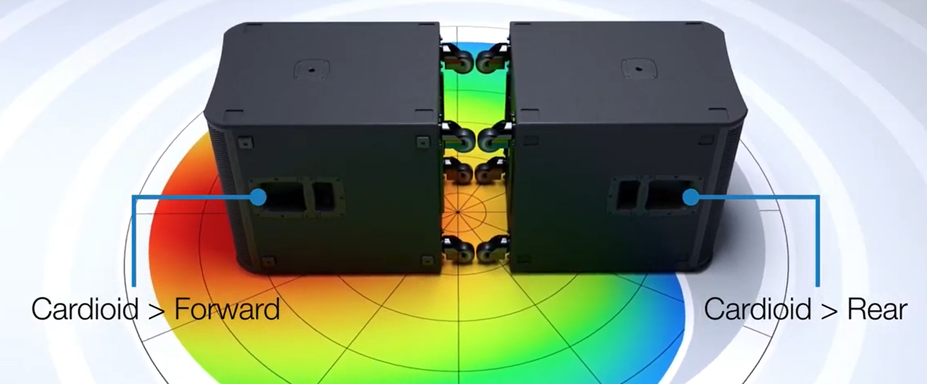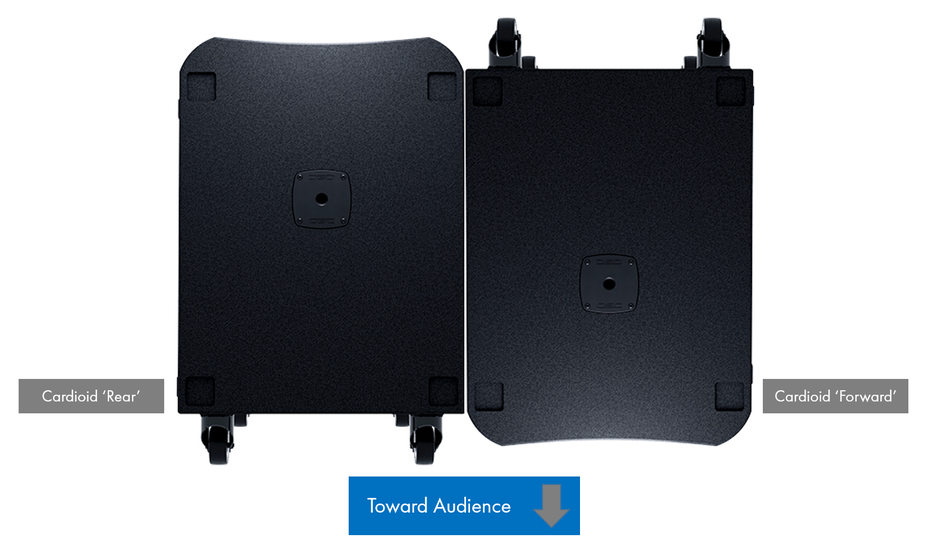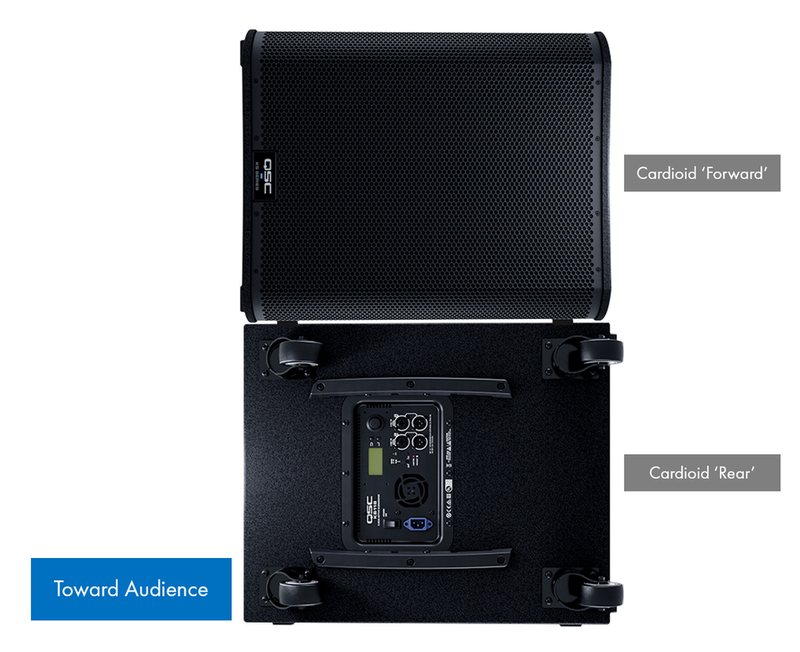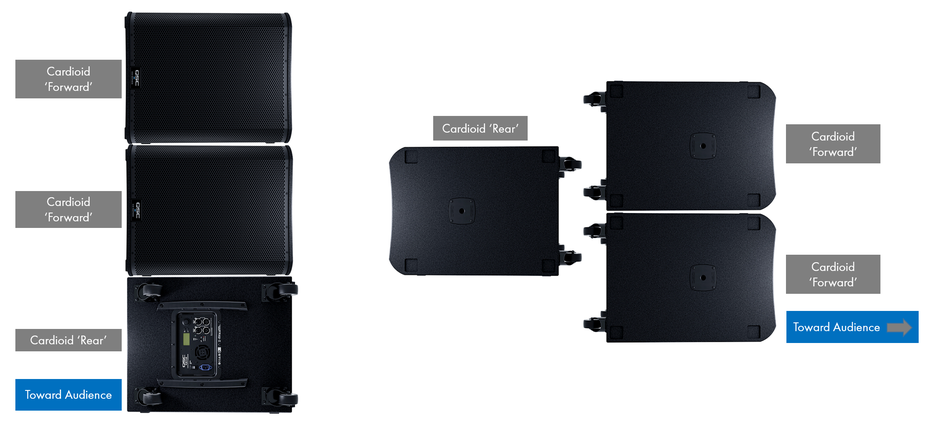To start, let’s recall that the low frequency energy radiated from a conventional subwoofer is effectively omnidirectional below 200 Hz. This is because the directivity of a subwoofer is related to the ratio of its size to the length of the sound wave it produces. The length, or size, of the sound wave is inversely proportional to its frequency, and therefore when low frequency waves are much longer than the dimensions of the subwoofer transducer and enclosure, the radiation pattern becomes effectively equal in all directions, including to the sides and rear.
The Directional Cardioid Radiation
Now, as we have all witnessed low frequencies omnidirectional radiation can sometimes be problematic, as it may cause feedback, create bass build up in some part of a room or disturb neighbors. Since the late 50’s sound engineers have setup subwoofer’s array using a minimum of two units, and with careful adjustments of delay, polarity, output levels and distance between the units, they managed to force the radiated energy to become directional. So, the term cardioid radiation – or heart-shaped – refers to the shape of the directional coverage in which levels are louder at the front of the unit and quieter behind it.
To implement such a cardioid radiation, two technical solutions can be used. Either design a fully cardioid subwoofer that features both front and rear-firing drivers within the same enclosure (QSC KS212C subwoofer), or employ two separate standard subwoofers together with on-board pre-programmed DSP presets that will provide either forward- or rear-facing radiation for each unit (QSC KS118 model). Working together the two units (more than two can be used, as we will discuss later) will combine to produce a cardioid radiation pattern with up to 15 dB of rearward rejection.
Cardioid Deployments
So, if two, or more, KS118 subwoofers can be arranged and configured to produce a cardioid radiation pattern very simply without complex calculations or processing settings required, a question we should answer is how to correctly position such a subwoofer array to get the best possible cardioid performance?
The processing necessary for cardioid operation is already programmed into each KS118 subwoofer’s DSP. On each subwoofer facing forward (toward the audience), the cardioid preset called ‘Forward’ should be selected and on each unit facing away from the audience, the preset ‘Rear’ should be turned on. Then, the same audio signal should be fed into both subwoofers with the same gain setting on each one.

The question is now how to physically position the subwoofers on the stage, or nearby floor surface. There are three possible deployments, and the choice is very dependent on the stage and venue layout, where the audience is in relation to the stage, the possible masking of video projections, etc.
A Good Choice: Side-by-Side
Placing KS118 subwoofers side-by-side (Figure 2) may save space and allow good visibility of the stage for the audience, but creates a cardioid pattern with limited precision.

A Better Solution: Stacked
Stacking two KS118 subwoofers on top of each other (Figure 3) offers similar results to the side-by-side arrangement. Of course, this setup clears the floor space, which is often beneficial in small venues.

The Best Option: Back-to-Back
Placing subwoofers back-to-back (Figure 3) offers the best cardioid performance, with 15 dB of sound attenuation at the rear of the array. The venue, or stage, should allow for such an arrangement, as it requires a little larger footprint.

Three Subwoofers Cardioid Arrangements
A three subwoofers configuration, with two forward facing and one rear-facing units, provides additional acoustic output at the front but with slightly less efficient rear attenuation. Once again, the stacked arrangement is less optimal than the back-to-back option.

Conclusion
Subwoofers’ cardioid deployments are very useful in a myriad of different production events and fixed installation applications. From keeping low frequencies spreading to neighbors’ home, to containing bass in a defined area (trade shows, conferences, seminars, etc), to minimizing bass feedback on stage or allowing multiple audio events to occur in the same large venue or outdoor, cardioid subwoofers’ rear attenuation (2x KS118 and one KS212C provide 15 dB level reduction) widens significantly the way you can use subwoofers.
Deploying multiple QSC subwoofers in a cardioid configuration is rather simple (check also our video on this subject), once you understand the benefits of each setup. Happy bass listening!

This is a great blog! Can this be done with an older KW181, or does it lack the correct processing on board to do so?
Hello, and thanks for your note. The KW181 does not feature the on-board DSP that would allow it to be used with another unit in cardioid mode. That feature exists in the KS118, while the KS212C is a permanently cardioid subwoofer.
I have one for my surf band. It is truly amazing. As the long time tour manager for The Ventures I can tell you all the hype and advertisement by QSC under-rated. This sub is fabulous. As Nokie Edwards, the legendary guitarist for The Ventures told me many times – never forget, as a musician, your product is sound.
Hi- I just bought two KS118s & K12.2s and am trying to work out the best set up for a corporate dance event. I’ve been told that it was better to have the two subs next to each other and the top speakers distanced on either side. Any advice? Thanks!
Hi Jason, and thanks for your question. The question of the best setup depends on the room and the venue. To get maximum SPL (mutual coupling) it is ideal to place the two subwoofers next to each other, and the loudspeakers on separate speaker stands on either side, pointing to the centre of the audience. If you do not need very high SPL, but rather balanced bass levels, then you can place each loudspeaker over one subwoofer using a speaker pole accessory, pointing the loudspeakers again to the centre of the audience. Both setups will perform very well. Hope this is useful. Best regards.
My system uses 4 subwoofers, 2-18″ jbl front loads and 2 JBL scoops with inverted JBL subs. What is the best placement position for these? The are powed by 2 QSC 5050’s bridged mono.
Hello Randy, and thanks for your question. The placement of the subwoofers depends largely on the settings of the electronics that is allowing the cardioid radiation. Adjustments of distance, level and phase rotation need to occur between the front and rear-firing units via the electronic unit. I have no single answer to provide. I would setup the subwoofer systems first, then setup the electronic unit; first apply the phase rotation of 180 degrees, next enter the actual distance between the transducers in the parameters, then adjust the level between front and rear systems. Careful listening is required as these parameters may need fine adjustments to get the best results. Hope this is useful. Best regards.
It I do the back to back option how much room do I need between the rear sub and the wall? I am on a stage that’s just big enough to do the setup but will only leave me about a foot of space in between the wall and the subs. I’m turn my dj booth and other equipment will be set up near it on the side. Do I need to set the subs up alone on a separate side stage to get the best effects?
Hello Nick, and thanks for your question. The answer is documented in the KS Series User Manual, page 8, using a KS212C cardioid subwoofer as example. The distance between the rear subwoofer and the wall behind it should be 20-in / 50 cm minimum. Why? In order to allow for the rear sound radiation to propagate properly and create the 15 dB rear attenuation desired. Subwoofers can be setup close to you, or on a separate side stage, the important point is that you allow for the above mentioned distance in your setup. Hope this is useful. Best regards.
Can this be achieved with two K-Subs
Hello Joseph, the K-Sub model did not feature the Cardioid radiation setting. So, the only way to configure two K-Subs for cardioid radiation is to use external electronic signal processing that can provide delay, phase and level adjustments. Hope this is useful. Best regards.
I plan to use 8 powered subs and 4 powered tops for an outdoor event (mid-point of a parade). On each side I plan to have two stacks, each stack having 2 subs stacked vertically and 1 top pole-mounted to the top sub. My intent is maximum SPL and not concerned with cardiod. How should I run cable from my mixer to each side? A splitter from each side to feed each stack per side? I will run mono of course
Hello, thanks for your question. If you are running a mono signal you likely need to daisy-chain all stacks (2 subs and 1 top each) from the mono output of your mixer. Make sure the subwoofer/top setups/stacks use a correctly adjusted crossover low-pass and high-pass), so that there are no overlaps in response between subwoofers and top loudspeaker. Hope this is useful. Best regards.
Is it proper to use the 212c center stage, and have two 18” subs left and right of stage?
Hello Josh, your setup suggestion is rather unconventional. The KS212C will radiate in its standard cardioid mode, while the other two KS118 will not. The sound coverage will be more likely omnidirectional, rather than cardioid, as the two KS118 will radiate in all directions. I would suggest you either use two KS118 on either side of the stage, or two KS212C for cardioid coverage. Hope this is useful. Besr regards.
Can you have a cardoid mode with a KS118 and a JBL 18″ that has the cardoid feature, or does it need to be both QSC?
Hello Donald, thanks for your question. As I do not have detailed info on the parameters used in the JBL model, I cannot guarantee that the cardioid radiation will be correctly implemented using these two models together. It might work. It might give you some cardioid attenuation, but I cannot specify here how much. Using two KS118 will provide the specified attenuation of 15 dB in the rear. Hope this is useful. Best regards.
Hello – I have 4 KS118s and 2 kw153s. What is the best way to route the audio through these to maximise SPL?
I was going to run 2 cardioids in stereo, but am struggling to work out the best audio routing
Would it be best to run the subs in stereo?
Hello Evan, thanks for your question. You basically have left and right KW153s loudspeakers. That is your stereo setup. Therefore, the easiest is to run say the left channel in the first KS118 sub, and its output (thru) will be connected to the input of the second KS118 sub. Now, you need to duplicate this for your right channel signal chain, and that should be fairly simple. Now, on each side you have two subwoofers, and so if you want to configure a cardioid setup, then one KS118 should be set to Cardioid Front, the other to Cardioid Back. And you must duplicate this on the other channel setup. As for the physical placement of these cardioid subwoofer pairs, the article above should give you the advices you are looking for. Hope this is useful. Best regards, C. Anet.